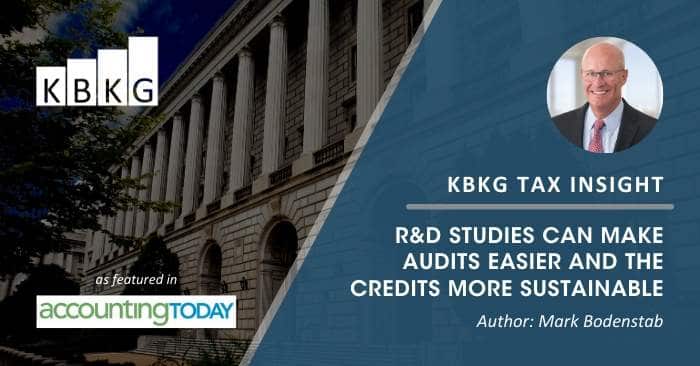As featured in Accounting Today
Internal Revenue Service examinations of the research tax credit can burden both the client and the IRS. Throughout most of its decades-long history, research credit audits have exposed areas of misunderstanding and, in many circumstances, led to major disagreements. There is little “bright line” guidance, and each examiner must consider the facts and circumstances of every case. A good research study provides those facts and will expedite acceptance of your research credit.
Many research credit studies serve two purposes. Initially, the study provides a sound definition of the credit for the benefit of the taxpayer and explains how the client meets the requirements for the credit in the Internal Revenue Code and Regulations. This is critical for a taxpayer focused on their busy operations with little time to understand and pursue the credit at the close of each successive tax year. However, when a taxpayer is selected for audit, the research credit study becomes the de facto explanation for the federal or state tax examiner. I had the opportunity (or misfortune) to review a myriad of research credit reports which demonstrated these two purposes that I label as boilerplate and substantiation.
While reciting the laws, definitions and cases is meaningful, experienced examiners already have a good handle on the information found in the boilerplate. Merely explaining the code and then stating, “Yeah, we did that” just doesn’t cut it. A good study will pre-emptively address an examiner’s concerns and should include these essentials of substantiation:
- An overview of your company and its products and processes. This description is for the benefit of the examiner and should correlate with research activities. Your knowledge of your company is instrumental in enhancing the examiner’s understanding.
- A consideration of non-qualified or excluded activities found in Treasury Regulation §1.174-2(a)(3) and IRC §41(d)(4). Many examiners reflexively concentrate on these at the outset of an examination. Be sure to differentiate your qualified activities clearly.
- Identification of employees in your organization who are performing research, supervising researchers and directly supporting research.
- A clear listing of the qualified research expenditures (QREs) claimed for the research credit, including the wages, supplies and contract research expenses defined in IRC §41(d). Be prepared to share your electronic spreadsheets with the examiner.
- An explanation of how those QREs meet the requirements of IRC § 41(b). This should include the identification of the technological uncertainty to be eliminated, the alternatives considered and the process of experimentation undertaken in evaluating those alternatives.
- A connection between the qualified research activities (QRAs) and your identified, specific business components related to the research activity, and the QREs associated with the QRAs. This is known as the “nexus” and is critical for an examiner’s understanding and acceptance of the credit.
- A review of the research credit computation, including a demonstration of the consistency between the QREs in the credit year and the QREs in the base years. Remember, an expense not qualified in the current credit year must be removed from the base year expenses, affecting the fixed-base percentage. Also, be sure to account for any acquisitions or dispositions.
- Remember that there is no required form of record-keeping, so proper substantiation of research activities will depend on the quality of your supporting documentation. Contemporaneous documentation consisting of timesheets, project budgets, timelines, emails, etc., contributed to my understanding of activities, so be sure to consider those in your explanations. If you do not have detailed project accounting data, consider a valid statistical sample or estimates supported by some objective basis.
It’s important to note that, on occasion, a third component, which should be avoided, appears in research credit studies: data dumping. Many experienced examiners are wary of the quantity of data when it is based solely on the weight of paper/giga-bytes of data. An examination is not an appropriate time to bury information and expect an examiner to find the needle in the haystack. Save everyone involved in examinations the time and hassle and present just the facts.
KBKG Insight: Good documentation is key in developing a sound explanation, and ultimately, in providing the examiner with a solid understanding of your research. Most importantly, make the effort to fully describe and document your processes of experimentation. As the recent Tax Court case of Siemer Milling Company v. Commissioner1 made clear last year, it is imperative for a taxpayer to substantiate their research activities. Among several takeaways, note that the judge did not determine that research did not occur, but that the taxpayer did not adequately document research activity.
The research credit is a catalyst for innovation and should be an asset to your business. Successful lean businesses frequently rely on external resources for assistance in the preparation of research credit studies. Whether before or after filing your return, good collaboration with your preparer can create a superior case study with the substantiation that is complete, understandable and defensible, ultimately making life easier for you and the IRS.
Learn more about the qualifying activities for the R&D tax credit and/or contact our R&D specialists to see if you qualify.
KBKG Provides Unique R&D Audit Defense Service
Did you claim the Research & Development (R&D) Tax Credit and are now under audit? Regardless of how you got here, we can help. With decades of research credit audit experience, we fully understand IRS audit techniques and procedures. Our firm can guide you through the audit process in the least amount of time while sustaining the maximum credit possible. » Learn more about our R&D audit defense service
Author: Mark Bodenstab
1Siemer Milling Company v. Commissioner, T.C. Memo. 2019-37 (2019).
Download: KBKG Tax Insight: Research Credit Studies Can Expedite IRS Tax Audits
About the Authors
 Mark Bodenstab – Director
Mark Bodenstab – Director
New Hampshire
Mark Bodenstab is a Director of the Research & Development Tax Credit Services, operating out of New Hampshire. Mark brings knowledge of many aspects of R&D from his 20+ years in the private sector as well as 14 years with the Internal Revenue Service (IRS). He joined the IRS as a General Engineer to provide technical and valuation support in the examination of large corporate tax filings. He has experience in a wide range of engineering issues, including the complicated credit for increasing research. » Full Bio


